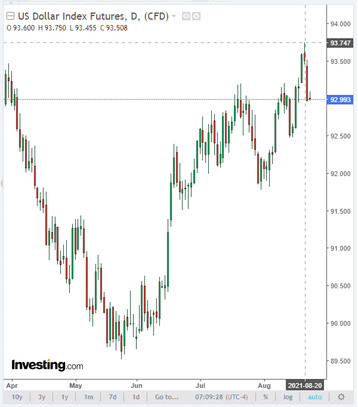As a result of last week's meeting, the Reserve Bank of New Zealand left its key interest rate unchanged, at a record low of 0.25%.
The day before, it was announced that for the first time since February, cases of Covid-19 infection were detected in New Zealand. As a result, a lockdown was introduced in the country, schools and most businesses were closed.
Prior to the detection of the delta strain of coronavirus in New Zealand, it was widely expected that the RBNZ would raise the official rate by 25 basis points at this meeting and announce the continuation of the process of phasing in the rate increase. The central bank's forecasts did imply an increase in the rate to 0.6% by December of this year and to 1.6% by December next year.
Rising government spending and lower interest rates in response to the pandemic have overheated the New Zealand economy, pushing inflation above the RBNZ target.
Although, in a companion statement from the RBNZ, the economy no longer needs the current level of monetary stimulus, the country's central bank nevertheless decided to keep the rate at a record low of 0.25% due to the uncertainty surrounding the Covid-19 outbreak.
This decision of the bank caused a sharp decline in quotations of the NZD. At the end of last week, the NZD / USD pair fell by 3.2%, to the mark of 0.6815.
Nevertheless, since the beginning of the new week, the NZD has been strengthening, while the NZD / USD pair is growing again. As of this writing, it is traded near the 0.6938 mark, receiving support from the weakening US dollar.
Although market participants are concerned about the spread of the delta coronavirus strain, which seriously threatens the pace of the global economic recovery, and the dollar enjoys the status of a defensive asset, nevertheless, the expectation of "pigeon" signals regarding the Fed's monetary policy from its head Jerome Powell on the upcoming economic Forum in Jackson Hole are putting downward pressure on the USD. While some of the Fed officials have recently spoken out in favor of starting to roll back the quantitative easing program, the central bank is unlikely to really start this process in the coming months, primarily due to concerns about the threatening spread of a new delta strain of coronavirus, including and in the United States itself.
Jerome Powell said last week that it is not yet known how the US economy will weather the recent rise in incidence. He also indicated that the restoration is not over yet. "The Covid pandemic is still affecting economic activity. We still feel it to a great extent. You see, we cannot declare victory yet", he said.
The USD was also negatively affected by the not very convincing macro statistics, which came from the USA yesterday. It reduces the likelihood of the Fed announcing the start of stimulus reduction.

The preliminary purchasing managers' indexes (PMI) for the manufacturing and services sectors in the US for August fell short of market expectations. Thus, according to the data of the research company IHS Markit, the growth of activity in the manufacturing sector and in the service sector of the USA slowed down in August. The purchasing managers' index for the services sector, which accounts for the largest share of the country's economy, in August fell to an eight-month low of 55.2 from 59.9 in July, and the index for the manufacturing sector - to a four-month low of 61.2 from 63.4.
On Friday, August 27, at a symposium in Jackson Hole, which will be held online, Jerome Powell will make a speech from which investors expect to learn about the Fed's action plans in the current difficult situation - rising inflation, the still incomplete recovery of the labor market and threats to the economy from the COVID-19 pandemic.
At the same time, the New Zealand dollar received additional support today from strong statistics from New Zealand. Thus, the volume of retail sales in the 2nd quarter of 2021 increased by +3.3% (after an increase of +2.8% in the 1st quarter and against the forecast of a slowdown in growth to +2.0%). At the same time, retail sales, excluding road transport, jumped by +33.3% in the 2nd quarter after growing by +6.6% in the previous 1st quarter.
Now, market participants trading in the NZD will pay attention to the publication at 22:45 (GMT) of the latest data on the trade balance of New Zealand. In recent months, New Zealand's trade balance has been on the surplus side, which is primarily due to strong demand for exports from the country, and which has a positive impact on the NZD. Another rise in the surplus will have a positive impact on the NZD, although it will be short-term.





